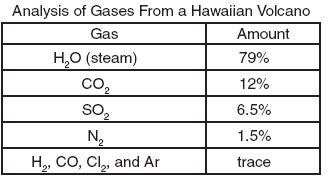

Released test questions, 2007 - Tectonics
Sample question #9.

Evidence suggests that Earth is about 4.6 billion years old, even though no Earth rocks have been found that can be dated at more than 4 billion years old. This discrepancy is most likely caused by Earth’s original crust being
Sample question #10.- difficult to date so precisely.
- subject to extensive erosion.
- blasted away during Earth’s formation.
- destroyed by solar radiation.
Notes
This is a difficult question because the relative importance of A, B and C require substantial experience.
A - need sense of relative accuracy.
...
Depending on whether the Moon is considered to have formed during the Earth's formation, it ...
Must point out that solar winds stripped gas, but not solids
This is a difficult question because the relative importance of A, B and C require substantial experience.
Which of the following is the best evidence that Earth’s continents were once in vastly different positions than they are today?
Notes
Sample question #20.- Penguins are found only in the Southern Hemisphere.
- Fossils of tropical plants are found in Antarctica.
- Volcanoes encircle the Pacific Ocean.
- Major rivers form deltas from continental erosion.
Notes
Which of the following provides evidence for plate tectonics?
Notes
Sample question #21.- sea-floor topography
- ocean currents
- Coriolis effect
- atmospheric temperatures
Notes
A rift valley is evidence of which kind of plate
Notes
Sample question #22.- convergent
- divergent
- transform
- uniform
Notes
The convergence of two continental plates would produce
Notes
Sample question #23.- island arcs.
- rift valleys
- folded mountains
- trenches
Notes
It is generally true that igneous rocks
Notes
Sample question #24.- contain primarily evaporites.
- can be scratched with a penny.
- normally contain fossils.
- are composed of silicate minerals.
Notes
Relative cooling rates of igneous intrusive rocks can be estimated by comparing rocks’
Notes
Sample question #25.- crystal sizes.
- composition.
- density.
- chemical reactivity.
Notes
Earthquake vibrations are detected, measured, and recorded by instruments called
Notes
Sample question #26.- sonargraphs
- seismographs
- Richter scales.
- magnetometers.
Notes
At which location would earthquakes be least likely to occur?

Notes
Sample question #27.
- 1
- 2
- 3
- 4
Notes
The Richter scale measures which of the following earthquake characteristics?
Notes
Sample question #28.- intensity
- magnitude
- frequency
- probability
Notes
Which type of volcano would be the least explosive?
Notes
Sample question #29.- cinder cone
- stratovolcano
- shield volcano
- composite cone
Notes
Which of the following energy sources is most likely to be abundant in California due to its position on a plate boundary?
Notes
Sample question #30.- wind
- nuclear
- solar
- geothermal
Notes
What energy resource is made possible by the volcanic activity in California?
Notes
Sample question #31.- hydroelectricity
- nuclear power
- geothermal energy
- solar energy
Notes
Geothermal energy is possible where there is
Notes
Sample question #32.- wind
- oil
- coal
- magma
Notes
The Long Valley Caldera in east-central California was formed by a massive volcanic eruption about 760,000 years ago. Since then, it has erupted several times. Of the following, which would be least likely to indicate that another eruption will soon occur?
Notes
Sample question #33.- recurring earthquakes in the vicinity
- decreases in precipitation in the area
- changes in gas emissions from the caldera
- uplifting of the floor of the caldera
Notes
Earthquake activity in California is primarily caused by
Notes
Sample question #36.- the lowering of aquifer levels.
- the interaction of tides with the coast.
- mining activity during the nineteenth century.
- plates grinding past each other along active faults.
Notes
Geothermal energy, a possible energy resource, is based on which phenomenon?

Notes
Sample question #49.
- There are concentrations of heat in some places of Earth’s crust.
- Earth’s internal energy heats its surface more than the Sun does.
- Heat energy from the Sun penetrates deep into Earth.
- Human activity is the largest source of heat energy on Earth.
Notes
Shifts in Earth’s continents most likely caused a change in Earth’s
Notes
Sample question #51.- climatic regions.
- mass.
- orbital velocity.
- atmospheric temperature.
Notes
Scientists have found fossils of tropical plants in Antarctica. How could tropical plants have grown in Antarctica?
Notes
Sample question #54.- At one time, Earth’s entire surface was a tropical rain forest.
- At one time, Antarctica was located closer to the equator.
- The rotation of Earth has increased, causing cooling of the atmosphere.
- Catastrophic volcanic eruptions melted the ice and exposed the soil to sunlight.
Notes

The table above lists the gases coming from a modern Hawaiian volcano. If ancient volcanoes gave off the same gases, which gas would have been most helpful in the development of early life-forms that could carry out photosynthesis?
Notes
- N2
- SO2
- CO2
- Cl2
Notes